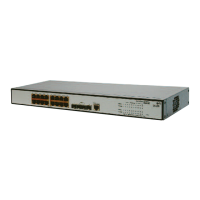1-13
z It is recommended to adopt the fast saving mode in the conditions of stable power and adopt the
safe mode in the conditions of unstable power or remote maintenance.
z If you use the save command after a fabric is formed on the switch, the units in the fabric save their
own startup configuration files automatically.
z The extension name of the configuration file must be .cfg.
Examples
# Save the current configuration to 123.cfg as the main configuration file for the next startup.
<Sysname> save main
The configuration will be written to the device.
Are you sure?[Y/N]y
Please input the file name(*.cfg)(To leave the existing filename
unchanged press the enter key):123.cfg
Now saving current configuration to the device.
Saving configuration. Please wait...
............
Unit1 save configuration flash:/123.cfg successfully
# Save the current configuration to 234.cfg in unit 1.
<Sysname> save unit1>flash:/234.cfg
The current configuration will be saved to unit1>flash:/234.cfg [Y/N]:y
Now saving current configuration to the device.
Saving configuration. Please wait...
...........
Unit1 save configuration unit1>flash:/234.cfg successfully
startup saved-configuration
Syntax
startup saved-configuration cfgfile [ backup | main ]
undo startup saved-configuration [ unit unit-id ]
View
User view
Parameters
cfgfile: Path name or file name of a configuration file in the Flash, a string of 5 to 56 characters.
backup: Specifies the configuration file to be the backup configuration file.
main: Specifies the configuration file to be the main configuration file.
unit unit-id: Specifies a switch by its unit ID. You can configure a switch in the fabric to use null
configuration when it restarts by specifying the switch unit ID in unit unit-id.

